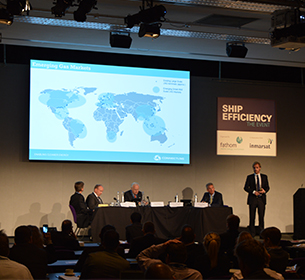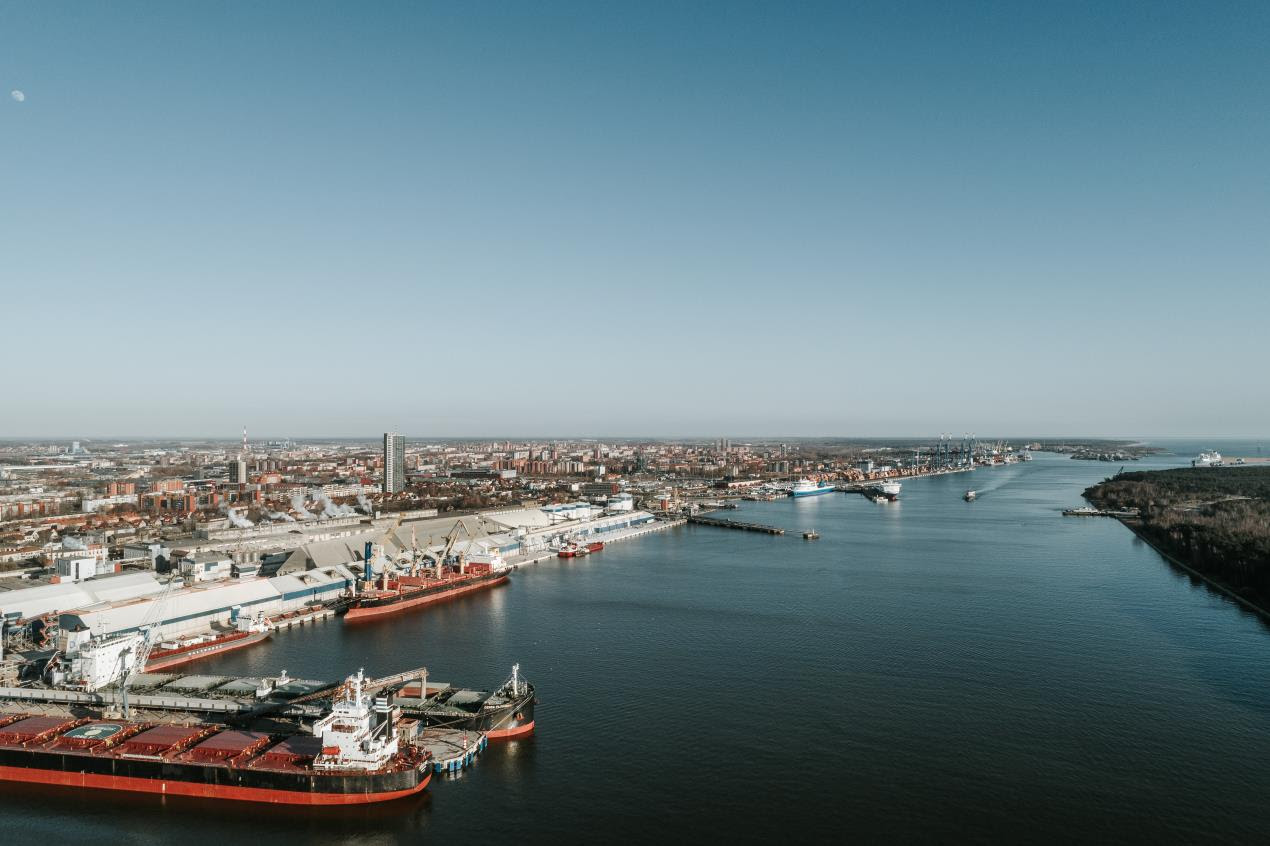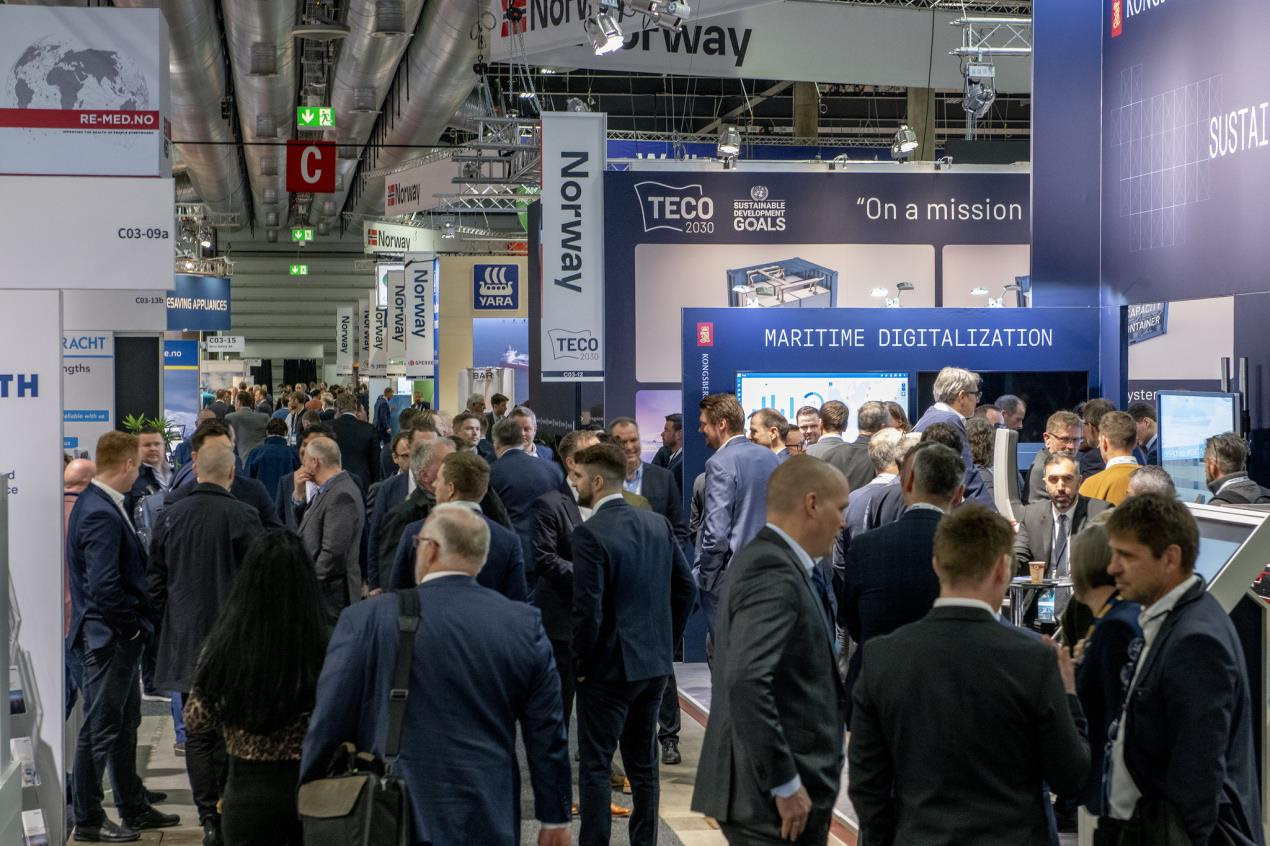This month, Fathom Maritime Intelligence put expert ship efficiency discussions firmly on the global agenda at the fifth annual Ship Efficiency: The Event, this year as an official part of London International Shipping Week.
Ship Efficiency: The Event 2015 saw more than 350 maritime professionals enter London’s Queen Elizabeth II Conference Centre for two days of debate, discussion, seminars, workshops and a bustling exhibition.
In this week’s industry spotlight, Fathom looks back at the successes and highlights of Day Two of Ship Efficiency: The Event 2015.
For a review of Day One of the event, please click here.
Ship Power & Design
– Efficient engines with ultra-low emissions for ships: the HERCULES project – Prof. Nikolaos Kyrtatos, Director of the Laboratory of Marine Engineering, National Technical University of Athens
– Practical guidance on efficiency gains – Markus Aarnio, Senior Vice President, Ship Technology, Foreship
– Hull & propeller efficiency monitoring – Edwin Schuirink, Technical Product Manager, VAF Instruments
Day Two of Ship Efficiency: The Event began with a session focussed on Ship Power & Design which was kicked off by Professor Nikolaos Kyratos, Director of the Laboratory of Marine Engineering at the National Technical University of Athens.
Prof Kyratos outlined the evolution of the HERCULES project, a long-term R&D programme initially designed to increase engine efficiency, reduce fuel consumption, carbon dioxide (CO2) emissions, gaseous and particulate emissions and to increase engine reliability. Since its conception in 2002, the project’s focus has shifted towards engine flexibility, environmental sustainability, and efficient shipping.
Prof Kyratos also discussed the possibility of different marine emissions reduction technologies for the future, including selective catalytic reduction (SCR), exhaust gas recirculation (EGR) and scrubbers to achieve emissions compliance and operational reliability & flexibility, and spoke of how integrated scrubber and SCR units should come into production in the next few years.
Markus Aarnio, Senior Vice President, Ship Technology, Foreship, followed with his presentation on practical guidance on efficiency claims. Optimisation of the ship for operational speed range rather than for one single speed was highlighted as a key factor in design, requiring optimisation of different parts of the hull separately and not as a whole. He also talked about the importance of optimising ship design for real operating conditions, as even a small alteration in wave dynamics can make a significant difference to the response and fuel consumption of the ship. For example, sometimes a ship is optimised and trialled for calm conditions, however, “the conditions are almost never calm”.
The final presentation of this session was led by Edwin Schuirink, Technical Product Manager, VAF Instruments who gave a talk on the importance of optical sensors, torque and thrust measurements in improving hull and propeller efficiency. Mr Schuirink drew upon the fact that approximately 30% of the world fleet is currently sailing with added resistance due to fouling, which significantly increases levels of fuel consumption and necessitates better performance monitoring and ship design optimisation. For instance, measuring the thrust provides information on the resistance of the ship, which allows “you to tell something about propeller performance.” As thrust is directly related to hull roughness, marine growth, trim and overall propeller performance, the quality of low-friction antifouling paint is vital. Mr Schuirink also voiced his belief on the importance of fuel quality for engine efficiency and not just having the right technologies onboard and creating awareness by innovative monitoring and performance feedback solutions.
Enabling Big Data
– Big data as a driver for innovation and value – Trond Leira, Chief Operational Officer, Inmarsat Maritime
– Implementing profitable data driven KPI’s – Capt. Jan Wilhelmsson, Director, Commercial Shipping, Eniram
– Crew communications and big data – Martin Reason, Director of Maritime Sales Europe, SpeedCast
– Phishing and piracy on the cyber seas – Joseph Carson, Head of Cyber Security, ESC Global Security
– APIs – where big data and the maritime industry meet – Peter Davis, Chief Technology Officer, Pole Star Space Applications
The next session focussed on big data, how to exploit it and the benefits derived from data analytics.
In the session’s first presentation, Trond Leira, COO, Inmarsat Maritime, talked the audience through the evolution of maritime communications and big data. He argued that uptake of big data analytics has been slow in the maritime industry for a number of reasons, including insufficient network capacity and flexibility, and proprietary provider infrastructure and hosting platforms. However, the potential impact of big data analytics on the industry is huge, not just in terms of increasing knowledge and understanding of ship performance, but also the associated cost savings resulting from access to maximised efficiency and a happy and productive crew. Mr Leira believes Inmarsat can help the industry realise these benefits through the provision of Fleet Xpress – global, mobile, reliable, and easy-to-use broadband communications for maritime users.
Capt. Jan Wilhelmsson, Director Commercial Shipping, Eniram, discussed the implementation of profitable data-driven Key Performance Indicators (KPI). Based on customer feedback, he found that reliance on experience and traditions have kept the maritime industry from implementing modern data-driven systems and processes on a large scale. Furthermore, too many operators are dismissive of 3-4% fuel savings, but when these savings are extrapolated to an annual figure, this oversight is“unthinkable”. He explained that data can translate into direct profits both by producing visibility that can reduce waste and as the basis for optimisation processes leading to increased profit margins. When embarking on the data collection journey, he advised to “start where the money is”, so where the effect on the bottom line is greatest, and stressed that it is when the data is processed, analysed and acted upon, that value is added.
The next presentation focussed on big data communications for crew welfare applications. Martin Reason, Director of Maritime Sales Europe, SpeedCast, explained how the growth of maritime satellite communications and high speed data was mainly driven by the increased use of data onshore, arguing that sailors are accustomed to it on land and expect it onboard as well. Against this background, it is not surprising that crew welfare is now the most important high speed data driver in the maritime industry. The problem is that crew data can interfere with business data, so according to Mr Reason, “crew control is a must over satellite.” Towards this end, SpeedCast offers pre-paid browsing, enabling the customer to give fair and equal access to data to each crew member by imposing time limits or data volume limits.
After lots of talk about the benefits of maritime satellite communications and big data, Joseph Carson, Head of Cyber Security, ESC Global Security, shone a light on the risks of the increasing use thereof: cybercrime! According to Mr Carson, phishing and piracy can occur wherever there is an Internet connection so the maritime industry needs to protect itself from this threat. With the biggest risk factor in any organisation being humans, the best way to do this is to offer employee security awareness training. In addition, he advised to continuously conduct vulnerability and detection assessments, to “assume you are breached”, be unpredictable and seek expert advice.
The session concluded with Peter Davies, CTO, Pole Star describing how Pole Star is putting application programming interfaces (API) into practice and presenting his company’s latest API project: PurpleTRAC. PurpleTRAC is a web-based solution which automates complex risk management and compliance procedures. Mr Davies explained that when entering the details of a ship, PurpleTRAC automatically looks up the ship’s details and receives confirmation from IHS, interrogates its Port State Control inspection records and analyses its historical movements to determine if it has recently called at a blacklisted port or sanctioned country. In addition, the system screens the ship and its associates against a comprehensive range of international sanctions lists. By combining these processes, PurpleTRAC results in significant time savings in ensuring compliance and managing or minimising risk.
Air Emissions Management
– Vessel shore connections – Peter Selway, Marketing Manager, Schneider Electric; Robert Hockham, Business Development Manager, Schneider Electric
– Hybrid solutions – Fini Hansen, Technical Superintendent, Scandlines
– Supporting compliance through emulsification – Stephen Bamford, Chairman, SulNOx
The conference continued post-lunch with a session on Air Emissions Management.
The first speakers of the session were Peter Selway, Marketing Manager, and Robert Hockham, Business Development Manager, both representing Schneider Electric. They discussed the potential for reducing exhaust emissions at berth using shore power and minimising noise pollution which affects nearby neighbourhoods. Mr Selway talked of the cost savings that can be gained by using shore power as ships can switch off their auxiliary engines and in most countries, the price of electricity is cheaper than the price of marine fuels.
Mr Selway also stressed the importance of planning in achieving the benefits. For instance, knowing what types of ships and how many are coming into port, and what the energy requirements are. This requires communication between the ship operator, the shipyard, and the port, ensuring that the shore to ship interface will permit shore power in particular. At the moment there are approximately 100 ports in the world where shore power is up and running.
Fini Hansen, Technical Superintendent, Scandlines, talked of the possibilities lying in hybrid propulsion and the concept of a zero emissions future. Mr Hansen explained that there is potential in battery power to become more fully utilised to reduce costs and emissions even further. Mr Hansen talked about the future of ferries and how Scandlines are likely to see further integration of a variety of technologies for zero emissions, including Flettner rotors, fuel and solar cells, modifications to the hull & propeller, as well as batteries.
Three of the possible ‘roadblocks’ to hybrid propulsion were also outlined. The first one is the need to build competence in large-scale shore side charging. Furthermore, the electrical infrastructure not currently developed to support large scale charging. The final major consideration is securing investment payback in order to safeguard a realistic business case, which Mr Hansen explained can be achieved through understanding the funding available and finance possibilities.
The last presentation of the session was given by Stephen Bamford, Chairman of SulNOx Fuel Fusions. Mr Bamford discussed the potential of blending fuels to improve fuel efficiency by up to 8%, while minimising engine degradation. The fuel emulsions have a proven shelf life of over two years and are compatible with any type of hydrocarbon fuel. Mr Bamford then explained how the water in fuel concept works. As the nano-emulsions of fuel and water combust, the water particles expand with force, leading to an explosion of smaller particles. The contact-surface area is increased between the fuel and the air, facilitating a complete oxidation process. This reduction in combustion time allows for a better combustion rate, and therefore efficiency, and a lower combustion temperature, which inhibits to some degree the formation of pollutants such as nitrogen oxides (NOx).
In addition, Mr Bamford spoke of the ease in handling and storing these fuels due to their safe composition and failsafe production with minimal maintenance, and briefly talked of SulNOx’s direct collaboration with organisations such as Lloyd’s Register and the University of Cambridge in developing low emission fuels for the future.
Environmental Management for Commercial Gain
– Eliminating discharges in oil/sea interfaces – a return to seawater lubricated propeller shaft lines for commercial ships – Craig Carter, Director of Marketing & Customer Services, Thordon Bearings
– Managing new wastewater regulations – Mark Beavis, Managing Director, ACO Marine
– Using lubrication selection to create wind in sustainability and operations – Jan Verdaasdonk, Director of Business Development, RSC Bio Solutions
The final session of the day turned around environmental management and how to turn it into business benefits.
Craig Carter, Director of Marketing & Customer Services, Thordon Bearings argued for a return to seawater lubricated propeller shaft systems for commercial ships. Currently, over 96% of the global fleet uses an oil lubricated propeller shaft bearing system and according to a research study, 130-244 million litres of lubricants are discharged annually during ship operations. In addition, the US 2013 Vessel General Permit (VGP) calls for use of Environmentally Acceptable Lubricants in all oil-to-sea interfaces in US waters and upcoming regulations under the Polar Code prohibit any discharge into the sea of oil or oily mixtures. According to Mr Carter, seawater lubricated systems can offer a highly cost-effective solution with a long predictable bearing wear life. He stated that “seawater is the only system that guarantees compliance and has zero impact on the environment.”There are currently over 600 commercial ships fitted with seawater lubricated propeller shaft bearings and numbers are increasing.
The next presentation focused on wastewater management and the changing regulatory requirements. Mark Beavis, Managing Director, ACO Marine made the audience aware that as of January 2016, a new performance requirement for sewage treatment plant will enter into force that introduces a dilution factor to testing procedures. Wastewater must now be fully treated, not simply re-configured or as Mr Beavis put it: “Dilution is not a solution to pollution.” He went on to discuss how to determine what wastewater management solution is needed. According to Mr Beavis, identifying the best suitable solution requires adopting a ‘complete ship’ philosophy. This includes, for example, understanding the ship profile in terms of operations and manning, the different treatment options as well as pre- and post-treatment procedures.
The last speaker of the Ship Efficiency Conference, Jan Verdaasdonk, Director of Business Development, RSC Bio Solutions, brought the discussion back to the topic of lubricants and compliance with US 2013 VGP requirements. However, contrary to Mr Carter, he advocates the use of high-performance Environmentally Acceptable Lubricants (EALs). He argued that against common perception, EALs often outperform petroleum-based products or at least match their performance. Using high-performing EALs not only reduces the environmental impact of lubricants, but can also improve fuel efficiency of the propulsion system, reduce maintenance needs and downtime and thereby overall increase the ship’s efficiency. Therefore, Mr Verdaasdonk advised conduct a holistic review of all lubricants and functional fluids used onboard in order to identify operational savings.
Following two days packed with insightful presentations and inspiring discussions around innovative technologies and performance strategies, Ship Efficiency: The Event culminated in the Ship Efficiency Awards ceremony. Hosted by Lloyd’s Register, the Ship Efficiency Awards 2015celebrated hard-earned achievement, ingenuity, far-sighted innovators and people pushing boundaries to enable progress.
For more information about the awards and the winners, please click here
With plans already in place for Ship Efficiency 2016, we look forward to welcoming you next year.
Fathom News


































